Summary
The nesting behaviors of many solitary ground-nesting wasps incorporate temporal barriers against would-be cleptoparasites. Nests being excavated are conspicuous but relatively invulnerable to parasites, while nests being provisioned, often several hours to days later, are inconspicuous but highly vulnerable, Argochrysis armilla, a cleptoparasite of solitary ground-nesting wasps, Ammophila spp., bridges the temporal gap between nest excavation and provisioning by (i) visually locating digging hosts, (ii) learning the locations of associated nests, (iii) maintaining surveillance on a series of nests during the hosts' absence, and (iv) ovipositing in nests when the host returns with provisions. Patterns of surveillance and parasitism of Ammophila dysmica nests were generated by the number of cleptoparasites discovering and learning the nest's location during excavation. These results support recent suggestions that learning may play an important role in shaping foraging strategies of insect parasites.
Similar content being viewed by others
References
Arthur AP (1981) Host acceptance by parasitoids. In: Nordlund DA, Jones RL, Lewis WJ (eds) Semiochemicals, their role in pest control. Wiley, New York, pp 97–120
Baker RR (1978) The evolutionary ecology of animal migration. Holmes & Meier, New York
Bohart GE (1970) The evolution of parasitism among bees. Fac Honor Lect, Utah State University, Logan, Utah
Brothers DJ (1975) Phylogeny and classification of the aculeate Hymenoptera, with special reference to the mutilidae. Univ Kansas Sci Bull 50:483–648
Cane JH (1983) Olfactory evaluation of Andrena host suitability by kleptoparasitic Nomada bees (Hymenoptera: Apoidea). Anim Behav 31:138–144
Carpenter JM (1986) Cladistics of the Chrysidoidea (Hymenoptera). J New York Entomol Soc 94:303–330
Eickwort GC, Abrams J (1980) Parasitism of sweat bees in the genus Agapostemon by cuckoo bees in the genus Nomada (Hymenoptera: Halictidae, Anthophoridae). Pan-Pacific Entomol 56:144–152
Evans HE (1958) The evolution of social life in wasps. Proc Intern Congr Entomol 10th, Montreal, 1956, vol 2, pp 613–617
Evans HE (1977) Extrinsic versus intrinsic factors in the evolution of insect sociality. Bioscience 27:613–617
Gould JL (1985) How bees remember flower shapes. Science 227:1492–1494
Gould JL (1986) The locale map of honey bees: do insects have cognitive maps? Science 232:861–863
Hassell MP (1978) The dynamics of arthropod predator-prey systems. Princeton, New Jersey
Iersel JJA van (1975) The extension of the orientation system of Bembix rostrata as used in the vicinity of its nest. In: Baerends G, Beer C, Manning A (eds) Function and evolution in behaviour. Clarendon, Oxford, pp 142–168
Jermy T (1986) The role of experience in the host selection of phytophagous insects. In: Chapman RF, Bernays EA, Stoffolano JG (eds) Perspectives in chemoreception and behavior. Springer, Berlin Heidelberg New York, pp 143–157
Lenteren JC van (1981) Host discrimination by parasitoids. In: Nordlund DA, Jones RL, Lewis WJ (eds) Semiochemicals, their role in pest control. Wiley, New York, pp 153–179
Lewis AC (1986) Memory constraints and flower choice in Pieris rapae. Science 232:863–865
Linsley EG, MacSwain JW (1955) The habits of Nomada opacella Timberlake with notes on other species (Hymenoptera: Anthophoridae). Wasmann J Biol 13:253–276
Menzel R (1985) Learning in honey bees in an ecological and behavioral context. In: Hölldobler B, Lindauer M (eds) Experimental behavioral ecology and sociobiology. Sinauer, Sunderland, pp 55–74
Papaj DR (1986) Interpopulation differences in host preference and the evolution of learning in the butterfly, Battus philenor. Evolution 40:518–530
Papaj DR, Rausher MD (1983) Individual variation in host location by phytophagous insects. In: Ahmad S (ed) Herbivorous insects host-seeking behavior and mechanisms. Academic Press, New York, pp 77–124
Rasnitsyn AP (1980) The origin and evolution of Hymenoptera. Trudy Paleontol Inst 174:1–190 [in Russian]
Rosenheim JA (1987a) Nesting behavior and bionomics of a solitary ground-nesting wasp, Ammophila dysmica (Hymenoptera: Sphecidae): the influence of parasite pressure. Ann Entomol Soc Am (in press)
Rosenheim JA (1987b) Parasite presence acts as a proximate cue in the nest-site selection process of the solitary digger wasp, Ammophila dysmica (Hymenoptera: Sphecidae). J Insect Behav (in press)
Rozen JG Jr, Eickwort KR, Eickwort GC (1978) The bionomics and immature stages of the cleptoparasitic bee genus Protepeolus (Anthophoridae, Nomadinae). Am Mus Novitates, no. 2640, pp 1–24
Rubink WL, Evans HE (1979) Notes on the nesting behavior of the bethylid wasp, Epyris eriogoni Kieffer, in Southern Texas. Psyche 86:313–319
Taylor RJ (1974) Role of learning in insect parasitism. Ecol Monogr 44:89–104
Vet LEM, Opzeeland K van (1984) The influence of conditioning on olfactory microhabitat and host location in Asobara tabida (Nees) and A. rufescens (Foerster) (Braconidae: Alysiinae) larval parasitoids of Drosophilidae. Oecologia (Berlin) 63:171–177
Wardle AR, Borden JH (1985) Age-dependent associative learning by Exeristes roborator (F.) (Hymenoptera: Ichneumonidae). Can Entomol 117:605–616
Wehner R (1981) Spatial vision in arthropods. In: Autrum H (ed) Handbook of sensory physiology, vol VII/6C. Invertebrate visual centers and behavior II. Springer, Berlin Heidelberg New York, pp 287–616
Author information
Authors and Affiliations
Rights and permissions
About this article
Cite this article
Rosenheim, J.A. Host location and exploitation by the cleptoparasitic wasp Argochrysis armilla: the role of learning (Hymenoptera: Chrysididae). Behav Ecol Sociobiol 21, 401–406 (1987). https://doi.org/10.1007/BF00299935
Received:
Accepted:
Issue Date:
DOI: https://doi.org/10.1007/BF00299935




